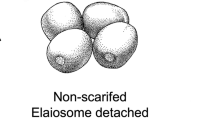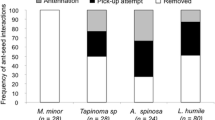Summary
Seed dispersal of the myrmecochorous Carex pilulifera (Cyperaceae) was studied in a wood land area in NE Zealand, Denmark. Nearly all seeds fell within a distance of 40 cm from the center of the parental plants. Ant dispersal of seeds was predominantly by Myrmica ruginodis. Data on foraging activity and seed transport into and out of the ant nest is presented. The resulting dispersal distances were between 0 and 1.4 m from Carex plants. It is suggested that the secondary relocation of seeds from the ant nest is of primary importance to the recruitment of seedlings. Formicarium experiments confirmed the myrmecochorous status of C. pilulifera, and demonstrated the function of the elaiosome and the attraction of fresh diaspores. Data on removal rates and ant activity is also presented and discussed. The study indicated that for a period the ant colony was nourished almost exclusively by C. pilulifera diaspores in the field. Information concerning M. ruginodis is presented, and the ant-seed mutualism is discussed.
Similar content being viewed by others
References
Beattie AJ (1983) Distribution of ant-dispersed plants. In: Kubitzki K (ed) Dispersal and distribution. Parey, Hamburg, pp 249–267
Beattie AJ, Culver DC (1978) Myrmecochory in Viola: Dynamics of seed-ant interactions in some west Virginia species. J Ecol 66:53–72
Beattie AJ, Culver DC (1979) Neighborhood size in Viola. Evolution 33:1226–1229
Beattie AJ, Culver DC (1980) The fate of Viola seeds dispersed by ants. Am J Bot 67:710–714
Beattie AJ, Culver DC (1981) The guild of myrmecochores in the herbaceous flora of west Virginia forests. Ecology 62:107–115
Beattie AJ, Culver DC (1983) The nest chemistry of two seed-dispersing ant species. Oecologia (Berlin) 56:99–103
Beattie AJ, Lyons N (1975) Seed dispersal in Viola (Violaceae): Adaptations and strategies. Am J Bot 62:714–722
Beattie AJ, Culver DC, Pudlo RJ (1979) Interactions between ants and the diaspores of some common spring flowering herbs in west Virginia. Castanea 44:177–186
Berg RY (1958) Seed dispersal, morphology, and phylogeny of Trillium. Skr Norske Vidensk-Akad Mat-Naturvidensk 1:1–36
Berg RY (1966) Seed dispersal of Dendromecon: Its ecologic, evolutionary, and taxonomic significance. Am J Bot 53:61–73
Berg RY (1969) Adaptations and evolution in Dicentra (Fumariaceae), with special reference to seed, fruit, and dispersal mechanism. Nytt Mag Bot (Oslo) 16:49–75
Berg RY (1975) Myrmecochorous plants in Australia and their dispersal by ants. Aust J Bot 23:475–508
Brian MV (1952) Interaction between ant colonies at an artificial nest-site. Entomol Monthly Mag 88:84–88
Brian MV (1955) Food collection by Scottish ant community. J Anim Ecol 24:336–351
Brian MV (1977) Ants. Collins, London
Brian MV (ed) (1978) Production ecology in ants and termites. Cambridge UP, Cambridge
Brian MV, Brian AD (1951) Insolation and ant population in the West of Scotland. Trans R Entomol Soc Lonc 102:303–330
Buckley RC (1982) Ant-plant interactions: a world review. In: Buckley RC (ed) Ant-plant interactions in Australia. Junk, The Hague, pp 111–141
Cammaerts MC (1977) Recrutement d'ouvriers vers une source d'eau pure ou sucrée chez la fourmi Myrmica rubra L. (Formicidae). Biol Behav 2:287–308
Cammaerts-Tricot MC, Verhaeghie JC (1974) Ontogenesis of the trail pheromone production and trail following behaviour in the workers of Myrmica rubra L. (Formicidae). Insectes Soc 21:275–282
Cammaerts-Tricot MC, Morgan ED, Tyler RC (1977) Isolation of the trail pheromone of the ant Myrmica rubra. J Insect Physiol 23:421–427
Christensen CM (1972) Microflora and seed deterioration. In: Roberts EH (ed) Viability of seeds. Chapman and Hall, London, pp 59–93
Collingwood CA (1979) The Formicidae of Fennoscandia and Denmark. Scandinavian Science Press, Klampenborg
Drake WE (1981) Ant-seed interaction in dry sclerophyll forest on North Stradbroke Island, Queensland. Aust J Bot 29:293–309
Handel SN (1976) Dispersal ecology of Carex pedunculata (Cyperaceae), a new North American myrmecochore. Am J Bot 63:1071–1079
Handel SN (1978) The competitive relationship of three woodland sedges and its bearing on the evolution of ant-dispersal of Carex pedunculata. Evolution 32:151–163
Handel SN, Fisch SB, Schatz GE (1981) Ants disperse a majority of herbs in a mesic forest community in New York State. Bull Torrey Bot Club 108:430–437
Heithaus ER, Culver DC, Beattie AJ (1980) Models of some ant-plant mutualisms. Am Nat 116:347–361
Keeler KH (1981) A model of selection for facultative nonsymbiotic mutualism. Am Nat 118:488–498
Kjellsson G (1985) Seed fate in a population of Carex pilulifera L. II. Seed predation and its consequenses for dispersal and seed bank. Oecologia (Berlin) 67:424–429
Kjellsson G (1985) Seed fall and phenological overlap in a guild of ant-dispersed herbs. Oecologia (Berlin) (in press)
Larsson SG (1943) Myrer. Danmarks Fauna 49. Gad, København
Mesler MR, Lu KL (1983) Seed dispersal of Trillium ovatum (Liliaceae) in secondgrowth redwood forests. Am J Bot 70:1460–1467
Nesom GL (1981) Ant dispersal in Wedelia hispida HBK (Helianthaceae: Compositae). Southwest Nat 26:5–12
Nordhagen R (1932) Zur Morphologie und Verbreitungsbiologie der Gattung Roscoea SM. Bergens Mus Årbok Naturvitensk Rk 4:1–57
Nordhagen R (1933) Über die Zuckerausscheidung der Samen einiger Colchicum-Arten und ihre biologische Bedeutung. Bergens Mus Årbok Natuvitensk Rk 2:1–15
Nordhagen R (1959) Remarks on some new or little known myrmecochorous plants from North America and East Asia. Bull Res Counc Isr Sect D Bot 7:184–201
O'Dowd DJ, Hay ME (1980) Mutualism between harvester ants and a desert ephemeral: seed escape from rodents. Ecology 61:531–540
Petal J (1978) The role of ants in ecosystems. In: Brian MV (ed). Production ecology of ants and termites. Cambridge UP, Cambridge, pp 293–325
Pudlo RJ, Beattie AJ, Culver DC (1980) Population consequences of changes in an ant-seed mutualism in Sanguinaria canadensis. Oecologia (Berlin) 46:38–44
Raunkiær C (1895–1899) De danske blomsterplanters naturhistorie. 1. Bd.: Enkimbladede. Gyldendal, København
Sernander R (1901) Den skandinaviska vegetationens spridningsbiologi. Upsala
Sernander R (1906) Entwurf einer Monographie der europäischen Myrmecochoren. Kgl Svenska Vetensk- Akad Handl 41 (7):1–410
Tutin TG, Fleywood VH, Burges NA, Moore DM, Valentine DH, Walters SM, Webb DA (eds) (1980) Flora Europaea 5. Cambridge UP, Cambridge
Wilson EO (1979) The insect societies. Belknap/Harvard, Cambridge
Wittmaack L (1979) De sociala insekterna. In: Kjellander E (ed) Insekter som hobby. Forum, Lund, pp 167–200
Author information
Authors and Affiliations
Rights and permissions
About this article
Cite this article
Kjellsson, G. Seed fate in a population of Carex pilulifera L.. Oecologia 67, 416–423 (1985). https://doi.org/10.1007/BF00384949
Received:
Issue Date:
DOI: https://doi.org/10.1007/BF00384949




